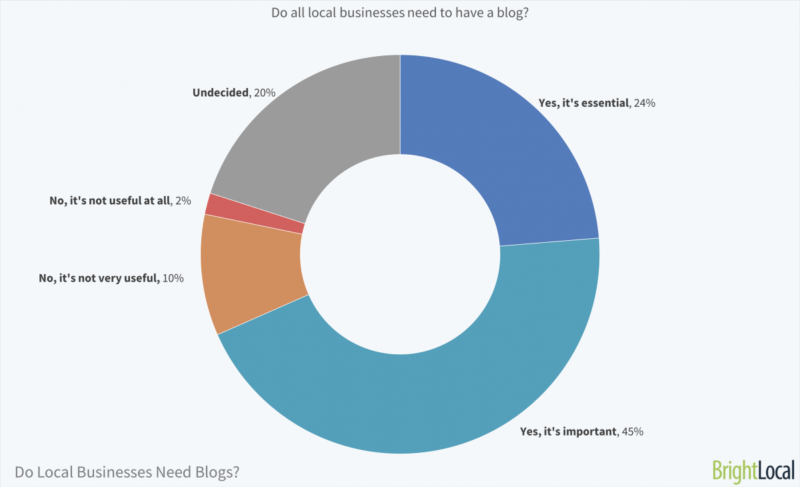 At every search conference, you hear the same click-bait question: “Is SEO dead?”
At every search conference, you hear the same click-bait question: “Is SEO dead?”
The short answer is “no,” and the longer answer is still “no,” it’s just changing. Maybe the term search engine optimization (SEO) isn’t really a good way to describe the wealth of practices and factors it encompasses anymore.
I’m convinced we’ll soon start to hear “Has content marketing been dethroned?” The argument for this, while still designed to get heads turning and tongues wagging, is particularly relevant for local businesses in the search world of 2018. As Google more firmly fits itself into the divide between a searcher and local business websites with featured snippets and the like, a more fitting question would be “Is there any point in local businesses doing content marketing?”
I’m here to tell you “Yes, it absolutely is,” and also share tips on:
- What to focus on with content marketing for local business.
- How it can help rankings and engagement.
- How to get great results on short time frames and even smaller budgets, which is critical for smaller SEO agencies.
Ready to place that crown back on content marketing’s head? Let’s go!
Do local businesses need blogs?
According to a poll of SEOs conducted earlier this year by my company, BrightLocal, 68 percent believed that local businesses still needed to have a blog in 2018.
Sure, the figure is over half the people polled, but it’s still surprisingly low considering how many respondents are likely to be blogging for local businesses themselves. Interestingly, 98 percent of respondents believed that local business blogs should be updated at least once per month.

I would argue that what we used to call a “blog” is now just a big old bucket of content that doesn’t quite fit anywhere else on the site. This term is still relevant for many companies (and, of course, for bloggers), but I’m not sure it fits the kind of content local businesses are likely to see the most success with.
Ask yourself this: Is anyone going to link to your local restaurant’s blog about its new oven? Is anyone going to search for, click through and read a legal office’s post about a new hire? Not likely. This kind of “newsy” stuff has its place, and it used to be in the blog, but no more.
So, what should replace the local business blog? You need something that’s going to trigger those all-important relevance and prominence factors in local search. Without content, how are you going to rank locally? Let’s look at the kind of content marketing that really works for local businesses.
Useful resources
No matter the size of the brand, every local business is exactly that: local. It’s playing in a reasonably small ballpark with a couple of handfuls of competitors at most. And what do visitors to new cities and neighborhoods want to find out online? Information about the place they’re visiting!
Creating evergreen or event-specific resources that serve a proven search need is an excellent way to win traffic to your site. Even better, this is the kind of stuff that gets continually linked to, even if it’s not 100 percent relevant to your niche.
Ever searched for some local information, found a list of “Ten Best Places to Eat In…,” and then asked yourself why there’s an attorney’s logo in the top-left corner? This is why.
Some ideas for useful resources:
- Attractively designed calendar of local events (conferences, meetups, concerts, festivals, sports games and so on).
- Lists of the best things for families to do in your local area (attractions, kid-friendly places to eat, parks and so on).
- Lists of best things to do tailored to visitors to a specific event (sports, bars and hotels, art show, galleries and so on).
- Extra information for visitors to an event (If the event hosts aren’t doing a great job of collating all event information in one place, go one better and write it all up yourself).
These resources are great bait for links. With a bit of outreach, and provided there’s not too much competition, you can find they can become the de facto piece of content for these kinds of searches. The best part is that they take very little effort and time to put together.
If you’re working with a multilocation giant wanting to play the local game, encourage them to put this sort of content into a local content silo for best results.
Useful how-to guides
Creating “how-to” content that sits under your “resources” tab is a great way of feeding the beast that is Google featured snippets. Success here will result in many more eyes on your brand.
Featured snippets come mostly as answers to questions, so what you need to do is answer them better than your competitors and in a format that’s structured up with schema so they’re voice search-friendly.
One advantage that smaller local businesses have over big brands is their ability to move quickly and try new things. In a recent webinar my company hosted, guest Matthew Hunt summed this concept up brilliantly by saying:
It’s the difference between trying to steer a cruise ship and steering a motorboat. The cruise ship is the big brand and you’re trying to dock it and you’re off course. There’s nothing you can do. It’s just going to crash. There are so many things in red tape that you need to do that it just keeps moving and it’s very hard to turn. But the benefit of working with a small business is this: it’s more like a speedboat. You can literally pivot at any time.
While your big-brand competitor is fretting about the design choices of their how-to guides and the production values of the video guide, you can grab a camera and make a video showing how to fix a garage door mechanism in minutes.
During the time it takes your competitor to wonder if this kind of content dilutes the brand, you’re transcribing the video and turning it into a simple, schema-filled bullet point list.
And while the big competitor starts drawing up a list of video production companies to talk with, you’ve hit publish and BOOM, the featured snippet is yours. Rinse and repeat for a multitude of well-researched, niche-relevant, question-based search terms and you’ll be swimming in visits, links, and even (if you pay attention to what I’ve got to say below) YouTube subscribers.
Useful videos
We’ve all heard the mantra of video being the fastest-growing form of content, but what has happened a second after that announcement is the flooding of thousands of videos into YouTube by unimaginative marketers.
Google’s video platform seems to be going through a bit of an identity crisis this year, not knowing how to (or whether to) pay creators, not knowing how to punish bad actors trying to game the system with artificial intelligence (AI) generated content, and not knowing when to just say good riddance to Logan Paul (in this author’s humble opinion, at least).
So out went subscribers and views as ranking factors, and in came what YouTube calls “Watch Time.” Confusingly, this isn’t the amount of time people have spent watching your videos; instead, it’s the average length of time a visitor watching your video stays on YouTube.
Yes, you read that correctly: In order to rank on YouTube and for your YouTube video to rank with a snippet in Google search, you need to figure out how to keep people on YouTube for the longest time possible. Here are some tips on getting people to stay on YouTube once they’ve seen your video:
• Upload good video only. Only upload good videos that answer a question and are relevant to the video title, because videos that make people switch off are YouTube poison.
By “good” I don’t mean “high quality,” I mean “useful and informative.” It’s out with the professionally shot video clip of your new office and in with the short overview of what to do first if your spouse has filed for divorce.
• Make longer videos. Plan longer series of short videos and split them up into clearly numbered parts, so that a viewer watching Part 1 will be compelled to stick with Part 2, as they’ll feel there’s more information to come.
Viewers who watch Parts 1 and 2 tend to stick around for Parts 3 to 10 and beyond, and YouTube will reward your channel for keeping them around. Segmenting video content into shorter but more numerous clips is far more likely to generate Watch time than a single 30-minute clip.
• Create previews. Make sure you include previews of and embedded links to your next (or most relevant) videos in your YouTube clip end screens. People are lazy and want to be told what to watch next.
• Create playlists. Sort your video series into playlists to make it easier for YouTube to know what to automatically show the viewer next. This also makes navigating your content on your YouTube channel page easier for viewers.
• Here’s a crazy Watch Time-improving trick that will blow your mind! Create playlists featuring anyone’s YouTube content, and it’ll still affect your Watch Time if people stick around to watch it after your clip!
Even if you create just one amazing clip that starts to get views, you can build out a playlist of the best content on a particular subject and put yours at the start. After all, what YouTube cares about most is the clip that brought the visitor to YouTube in the first place.
Conclusion
Blogging may no longer be vital for small businesses, but much like “SEO,” maybe “blogging” isn’t the right word for it anymore. The process is the same, and it’s quicker and cheaper to do for local businesses than ever before.
Find out what it is people want to know. Create useful content specific to your niche or location. Get it out in the wild via outreach, social sharing and Google My Business Posts. Monitor performance, rinse, repeat and bask in the glory of more links, more traffic and better rankings.
Opinions expressed in this article are those of the guest author and not necessarily Search Engine Land. Staff authors are listed here.
